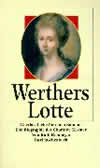Fembio Specials Famous Women from Hanover, Germany Charlotte Buff-Kestner
Fembio Special: Famous Women from Hanover, Germany
Charlotte Buff-Kestner

(Charlotte Kestner, geb. Buff)
German housewife and mother, “Werther's Lotte”
born 11 January 1753 in Wetzlar
died 16 January 1828 in Hanover
250th birthday on 11 January 2003
175th anniversary of death on 16 January 2003
Biography • Literature & Sources
Biography
Charlotte Buff-Kestner became famous because the 23-year-old poet Goethe, at the time still almost unknown, fell passionately in love with her in the summer of 1772. Although this love could not be fulfilled, since Charlotte was already promised to Johann Christian Kestner, it inspired Goethe to write his emotionally driven Die Leiden des jungen Werther (The Sufferings of Young Werther), published in 1774. This novel, which struck the nerve of the era, took Europe by storm and was far more influential than Goethe's later works. Werther became a cult-figure for a whole generation, but was also criticized as provocative and a threat to customary morality. The novel was translated into many languages, imitated, “corrected,” even occasionally forbidden—whereupon it would be circulated secretly from one reader to the next.
In the meantime Charlotte had married Kestner and moved into his family home in Hanover. Her husband felt that he and his wife had been “grievously exposed and prostituted” and anticipated the kind of gossip that would haunt them in status-conscious Hanover. While it remained unpleasant to him for the rest of his life to be associated with the role of “Albert,” Lotte—with her sunny tranquillity and practicality—took clever advantage of her reputation, chiefly to secure protection and support for her sons' careers.
In 27 years of marriage she bore eight sons and four daughters, managed the large household with skill, energy and thrift, and, given her cheerful, kind nature and firm trust in God, was popular with everyone. Kestner died unexpectedly in May 1800 while on a business trip. Charlotte was able to keep the large, widely dispersed family united on a basis of unusual loyalty and solidarity, shown in particular by the older siblings for the younger, and by her daughters for her sons. Thus they were even able to survive the difficult and uncertain years of the French occupation—with its required contributions of money and quarters, its absent pension and salaries—with relative success.
The Kestner sons rose into the wealthy upper-middle class and married women of respected families. The most famous was August (the “Roman” Kestner), whose passion for collecting eventually led to the founding of the Kestner Museum in Hanover.
The 1816 meeting of Charlotte and Johann Wolfgang Goethe in Weimar, later rendered by Thomas Mann in Lotte in Weimar, remained politely cool. Charlotte Kestner died after a brief illness, deeply mourned by her large family and many friends. Her grave can be found in the Garden Cemetery in Hanover.
Author: Adelheid Steinfeldt
Literature & Sources
 Goethe, Johann Wolfgang von. 2002 [1774]. Die Leiden des jungen Werthers. Frankfurt/M. Suhrkamp Basis Bibliothek 5.
Goethe, Johann Wolfgang von. 2002 [1774]. Die Leiden des jungen Werthers. Frankfurt/M. Suhrkamp Basis Bibliothek 5.
Mann, Thomas. 1999 [1939]. Lotte in Weimar. Frankfurt/M. Fischer TB. <
Rahmeyer, Ruth. 1999 [1994]. Werthers Lotte: Goethes Liebe für einen Sommer. Frankfurt/M. Insel TB.
If you hold the rights to one or more of the images on this page and object to its/their appearance here, please contact Fembio.


